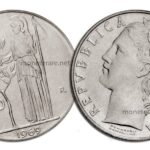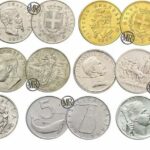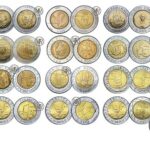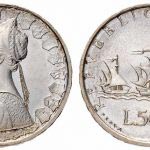The 500 lire banknote is one of the most important and sought-after historical pieces of Italian numismatics. Let’s go through in this page the long historical path and the vicissitudes of this 500 Lira banknote.
The National Bank’s 500 lira banknotes
The first printing of the 500 lire banknote was made in Italy in 1874 by the National Bank in the Kingdom of Italy. The period was that one of the Kingdom of Italy and King Vittorio Emanuele II.
Originally, this Italian banknote was printed on one side only and bore the inscription “Banca Nazionale”, the value of the banknote as well as the coat of arms of the cities of Turin and Genoa and the bust of Christopher Columbus at the bottom centre.

The dimensions of the first 500 Lira note were 220 X 130 mm. This banknote was printed under King Vittorio Emanuele II in the years 1874 – 1875 – 1876 – 1877. Later they will be printed also under King Umberto I in the years 1881 – 1885 – 1887 – 1889 – 1893 and by the new Bank of Italy in 1894 – 1895.
Italian 500 Lire Banknote “Banco di Sicilia” of 1876
These particular Italian paper banknotes are highly sought after. If kept in good condition they can be worth up to €3,000. A very interesting and noteworthy figure.

Italian 500 Lire Banknote “Banco di Napoli“
Banco di Napoli 500 lire banknotes, if kept in good condition, can be worth as much as €7,500. A restored banknote depicting Leonardo da Vinci printed in 1903 is worth as much as €6,500. Even if the banknote has been restored, it still has great economic value.

Italian 500 Lire Banknote “Big C”
Later, the Bank of Italy made changes to the first 500 lire banknote. In fact, the 500 lire paper banknote was illustrated by the Sienese artist Rinaldo Barbetti in 1896. This particular edition is also called the “Big C” (Grande C). Do you know why?
Thanks to the size of the “C” in the inscription “Cinquecento”. The same banknote, with small variations, was also printed in 1950 and was declared out of circulation in 1953. The 500-Lira note designed by Barbetti remained in circulation for 57 years.

Value of Italian 500 Lire Banknote “Big C” (Grande C)
If you own a 500 lire banknote from 1950, you could be holding a piece of history worth over €10,000.
Now, if you have rare banknotes like these (but also different ones), you can have fun and earn some money by auctioning them online. We always buy and sell coins and banknotes at auction using this partner site. It’s the largest online coin auction site and we recommend it. Both selling and buying coins or banknotes at auction is easy and exciting.
Italian 500 Lire Banknote “Capranesi“
This Italian banknote was first printed in 1919 and was designed by Capranesi.
Capranesi’s 500 lira banknotes depict on the back one of the two sculptural monuments that triumphed above the facade of Palazzo Koch in Via Nazionale in Rome, which was then the headquarters of the Bank of Italy.

The three sculptures represent, starting from the left, Industry, Agriculture and Commerce. The sculptural group was created by the chisel of Nicola Cantalamessa Papotti. Later, in 1930, the sculptures were removed to protect the stability of the facade itself.
Around the depiction of the monument there is a crown of leaves and two smaller ovals flanking the central one.
On the right is the circle reserved for the watermark, and on the left the one depicting the golden eagle with the Savoy coat of arms. On the front, on the other hand, there is the figure of the reaper sitting on the sheaves with a scythe in her hand.
This banknote was printed from 1919 to 1943 and had a total circulation of more than 63 million pieces.
Value of Italian 500 Lire Banknote “Capranesi”
If you own an Italian 500 lire banknote like this one, you should know that its value is around 900€.
Italian 500 Lire Banknote “Ornata di Spighe” (Adorned with ears of corn)
Here is another version of the 500 lire Italian banknote. This particular one was issued in 1947 and signed on the watermark by Luigi Einaudi, then Governor of the Bank of Italy.
For this edition of the 500 lire, the banknotes were transformed by reducing their size to 146 x 70 mm. The printing was carried out by the Bank of Italy’s printing works.
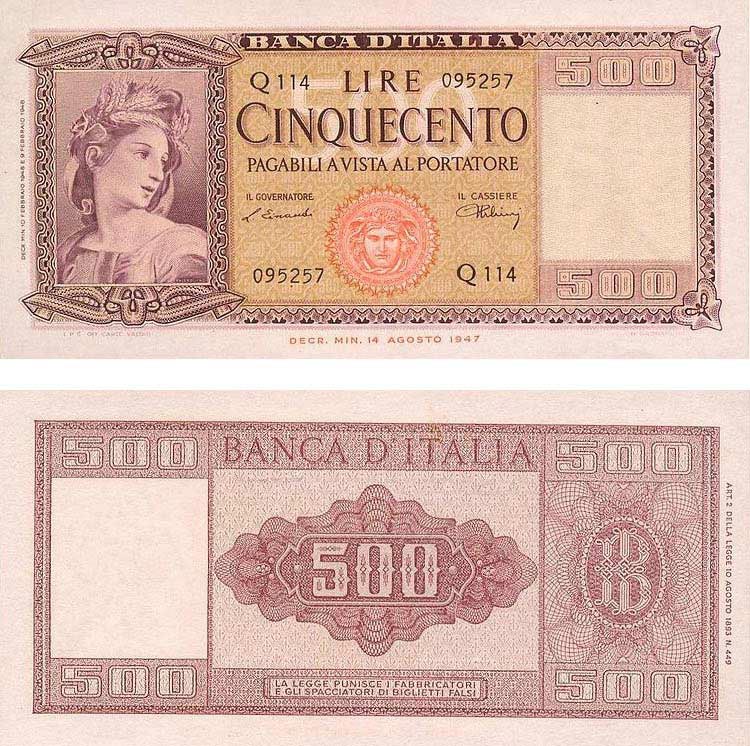
Made on the front and back of white paper with a paste watermark, these 500 lire depict, on the front, part of Raphael Sanzio’s painting “Venus, Juno and Ceres”. painted by the artist in the Loggia of Psyche at the Farnesina in Rome.
The painting by the Tuscan artist is an allegorical symbol of Italy and the banknote depicts a detail of Ceres’ face with her head adorned with ears of corn. Hence the name of the banknote.
The banknote, called “Italia Ornata di Spighe”, circulated until 1953 together with the previous versions, after which they all went out of circulation on 30 June of the same year.
From 1953 to 1958, no 500-Lira banknotes circulated in Italy.
Value of Italian 500 Lire Banknote “Ornata di Spighe”
If you own a 1947 “Italia Ornata di Spighe” banknote, you can easily sell it at auction (on this website) and find a bidder for €400.
The Italian 500-Lira Silver Coin with the Caravels
After a long pause from the paper 500 Lire denomination, in 1858 the State tried again and issued a Silver coin worth 500 Lire. It is the famous 500 silver lira of which we have talked a lot in the page dedicated to them: the 500 silver lira with the caravels.
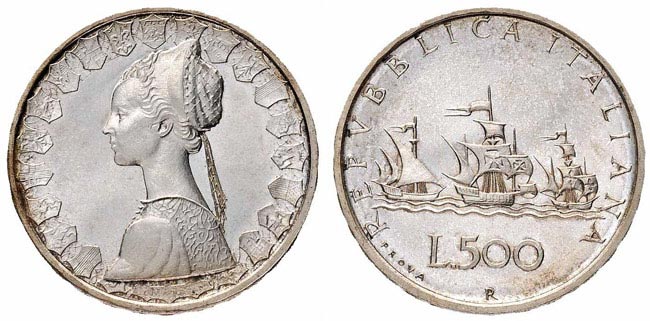
This silver coin, however, was soon replaced because of the excessive cost of production. If you want to know more about the 500 silver italian lira, on this page you can find all the information about this coin, the current market quotations, the minting errors and the different printing runs that took place before its definitive disappearance.
Value of the 500 Silver Lire Coin
The great peculiarity of this Silver coin is the flag of the Caravel. If the flag flies to the right (in the direction of the wind) it is a common specimen. If the flag of the caravel flies to the left (against the wind) it is a very rare coin and sought after by numismatic collectors all over the world and its value could be around 15.000€.
The 500 American Banknote Lira “AM-Liras”.
After the fall of Mussolini’s government, in the years between 1943 and 1946, there was a period of transition in Italy and the US Command had AM – Lire banknotes printed. “AM” stands for “Allied Military Currency”.
The AM-Lira were US dollar-sized banknotes and carried their value in both Italian and English. Of course, there was also the 500 AM-Lira note.
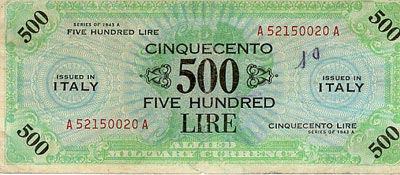
On the back were the four freedoms enshrined in the American Constitution: Freedom of speech, Freedom of religion, Freedom from want, Freedom from fear.
It was a legal tender currency. It was used throughout the Italian territory subject to the Military Government for payments of any amount! No one could refuse to accept it. These 500 paper lira circulated throughout World War II in the following denominations: 1, 2, 5, 10, 50, 100, 500, 1000 lira.
At the end of 1946, on 12 December to be precise, the AM lira became to all intents and purposes an Italian currency and no longer an American one. They remained in circulation until 30 June 1950 before being definitively out of circulation.
Value of 500 Lira “AM-Lira” banknotes
This controversial banknote, which bears witness to such a particular period in Italy’s history, can be worth over €1,000 if it is in good condition.
Italian 500-Lira “Arethusa” State Ticket
Later, in the 1960s, and precisely in 1966, a 500-Lira State Ticket was printed. These 500 lire notes are printed by the Istituto Poligrafico e Zecca dello Stato, signed by the treasurer of the Ministry of the Treasury.
It was not a banknote issued by the Bank of Italy but a government bond, so seigniorage was directly due to the state. In fact the wording was no longer “Bank of Italy” but “Italian Republic”.
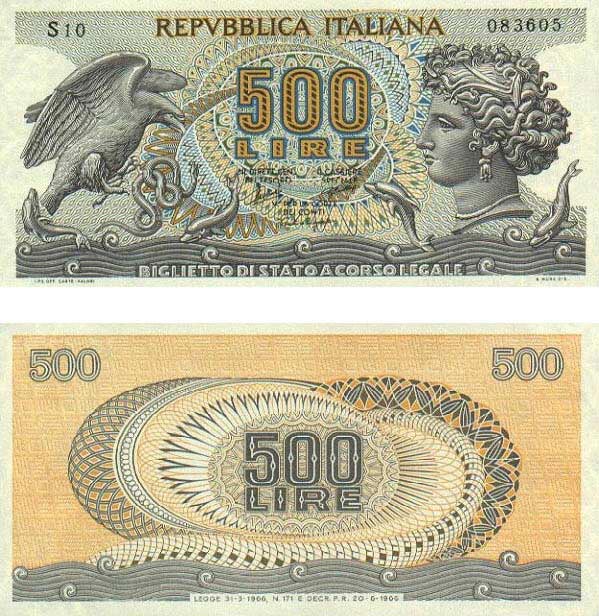
It was introduced to replace the 500 lire silver coin (the one with the caravels), whose production costs became too high due to the increase in the price of silver.
The dimensions of the new banknote, which have been further reduced compared to previous banknotes, are now 110 x 55 mm. On the front, the banknote depicted the head of the Nymph Arethusa with the symbols of the Dolphins, the Eagle and the Snakes around it. With cornucopias on the watermark.
Value of the State Ticket Arethusa
A 500 Lire Aretusa banknote in good condition from 1975 can be worth around 300€. On the other hand, owning a very rare version (from the B6 replacement series) could earn you even more than 600€. This is the site we recommend to buy and sell Italian and international banknotes.
500-Lira “Mercury” State Ticket
In 1974, a new 500-Lira state banknote was issued, printed by Poligrafico dello Stato. The dimensions of the new banknote increased slightly compared to the previous version and became 115 x 59 mm. The “Mercury” banknote was printed in 1974 – 1976 – 1979.
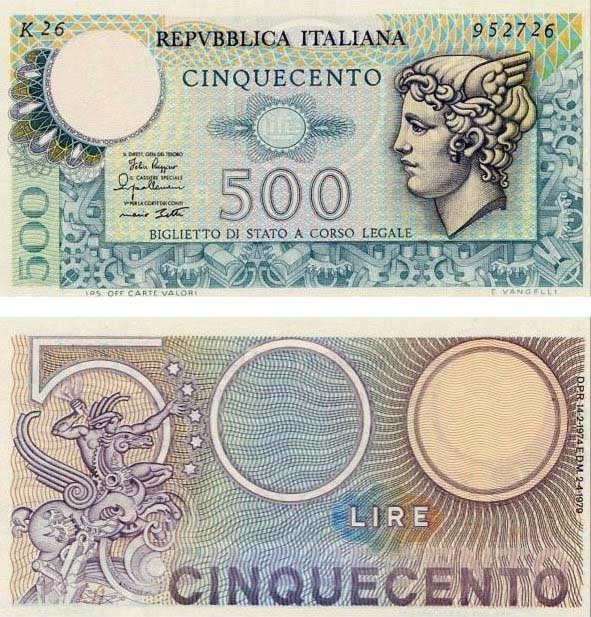
This particular denomination of Italian banknote, depicting the head of Mercury on the front, became the last Republican paper issue. In fact, it was replaced by the Bimetallic Coin in 1982.
This is an extract from an article of 25 February 1986:
25 Febbraio 1986 – FUORI CORSO’ DAL 28 FEBBRAIO LE BANCONOTE DA 500 LIRE
ROME – On 28 February, 500 lire notes will be discontinued and replaced by the bimetallic coin of the same value, which is already in circulation. Whoever is still in possession of the banknote has until that date to “sell” it or exchange it at the bank. After 28 February, the 500 lire notes will go “out of circulation” and in order to exchange them it will be necessary to go to the counters of the Bank of Italy or the Central Treasury. No new 500 lire banknotes will be issued.
Value of the Mercury State Ticket
If you own a “Mercury” state ticket you should know that its value is around 70€ /100€.
The Italian 500-Lira Bimetallic Coin
In 1982 the new 500-Lira bimetallic coin was issued after the silver one with the caravels.
The coin was composed of two metals. The innovative use of more than one metal was necessary to counteract the high level of coin forgery.
We have talked a lot about this type of Italian 500 lire in this article: Italian bimetallic 500 lire coins.
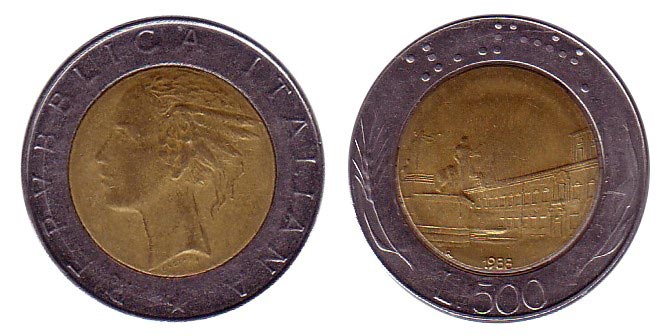
The patent for the manufacture of the double-metal, double-colour coin was submitted to the Ministry of the Treasury in July 1981. Another innovative feature was the appearance of the Braille character and the discontinuous contour.
The metals used were Italian-made Bronzital and Acmonital. No wonder their combination was called ‘Italian Marriage’.
Curiosities about the 500 Lire Bimetallic Coins
More than 162 million 500 lire bimetallic coins were produced in 1982.
One of these is kept and exhibited at the British Museum in London and many were collected early on by tourists visiting Italy. You too could have one in your attic and not know it!
Didn’t find what you were looking for? Check these topics:
- To find out all about the Gold Sovereign coins, click here.
- If you are looking for Rare Euro Coins then click here.
- Rare Italian Lira and their great value has been dealt with here.
- To Sell or Buy Rare Coins Online, read these tips.
- All information on Italian 500 Lira Silver Coins is here.
- We have talked about the Italian 500 bimetallic lira here.

